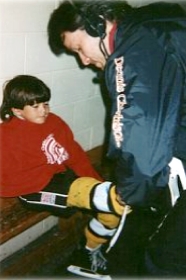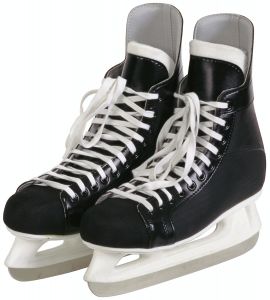Painful Skates
Q: An Arizona-based hockey mom writes me seeking some oft requested advice… She says that her boy has been complaining about his skates a lot lately, and that he’s even cried at times because his feet hurt so badly. Then, noting that the current skates are hand-me-downs from a cousin, she asks for advice in the purchase of her son’s first pair of new hockey skates.
A: Not that there is a single piece of UNimportant hockey gear, but… If I had to prioritize equipment purchases, I’d allot the majority of my budget to 1) good quality, properly-fit skates and 2) a safe helmet and mask assembly. Thereafter, go with used or hand-me-down stuff. (As an FYI, my next focus would be on those articles of equipment that can either slow or help quicken hand and foot movements.)
Now, passion for the rink is paramount to any player’s growth. I mean, it’s essential that he or she really look forward to getting to the next practice or game. However, as this hockey mom is discovering, skates can have a huge bearing on a youngster’s comfort and enjoyment during the learning process. They’ll even affect a beginner’s ability to execute various movements and to thusly gain the confidence to take-on far greater challenges.
So, starting with the initial problem, let me bet my house on the likelihood that my young Arizona friend’s skates are either too small or they are being tied improperly. I’ll deal with the first point shortly, but let me initially explain the skate-tying process…

Appreciate that nothing — I said nothing — can be done to overcome skate-boots that are either broken-down or too large. Additional support can’t be found in extra pairs of socks. And, pulling the laces too tightly over the arch-area will likely cause pain in of itself, and also cut-off blood flow to the toes. This in mind, the lowest eyelets should only be tied like sneakers or dress shoes. Just about all of a skate’s support is found in the boot’s ankle-area. So, it’s essential to seat the heel all the way back into the boot, and then snug-up about the top three eyelets so that the leather (or whatever) is pulled firmly around the ankle. Don’t wrap excess lacing around the ankle, but instead tie a double-bow or acquire the correct length laces.

As for proper fitting, appreciate that we can’t feel through the toe of a skate as we might shoes or sneakers. So, it’s necessary to reverse the measuring procedure… Remove most of the lacing so that the tongue of the boot can be pulled all the way forward. Next, have the player slide his or her foot all the way forward until the toes hit the end of the boot. This done, measure the excess space left between the player’s heel and the back of the boot. To derive the most support and feel from the boot, this excess space should be no more than about the width of a pencil.
Then, on socks and growth… Fitting might be done while the player is wearing thin sport-hose. As growth occurs, the thickness of the socks might be reduced. (FYI… A lot of my advanced players have worn women’s knee-highs — for a lot of reasons. And, a great many advanced players prefer making themselves feel “one with the boot” by going barefoot.)
Finally, I’m guessing something within the above helps that hockey mom solve her lad’s problem. Still, if she or her husband has a related question or needs clarification, I invite them to email me directly. Good luck!